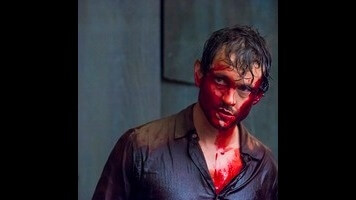Hannibal: “Primavera”

In “Antipasto,” the premiere episode of Hannibal’s third season, we were treated to an arthouse view of what Hannibal and Bedelia had been up to since the bloody showdown at Hannibal’s Baltimore condo last season. Now, it is Will Graham’s turn for a catch-up episode. In many ways, “Antipasto” and “Primavera” are very similar in the way they deal with the dueling central figures of the show. And, still don’t answer many of the questions still left open after the massacre of that was the end of the second season. There are two major characters still left unaccounted for, Laurence Fishburne’s Jack Crawford and Caroline Dhavernas’ Dr. Alana Bloom. While the show’s overall artiness and lack of fear over being too pretentious (“The first thing I tell any new director is ‘You are making a pretentious art film.’ This is not an episode of television. This is a pretentious art film,” creator Bryan Fuller told RogerEbert.com) for the average TV viewer, not to mention the way it handles gore and violence, has very much separated Hannibal from other network (and even a lot of cable) shows. Through “Primavera,” we get a hint about the timeline and know what Will is up to (and, alas, Abigail’s fate), but little else about what has happened back in Baltimore in the ensuing eight months. But this insistence on not revealing its hand, of not immediately serving up the information its audience craves, is another big sign. Like Hannibal himself, the show has been dangling us like prey, saying “We’ll tell you who is alive when we’re good and ready.”
(That being said, Hannibal is pushing it a bit for me on the arty front. Look, I love the imagery of blood waves as much as the next girl, but I’m also a fan of straight narrative TV and sometimes that’s what I crave over something inherently more complicated than that. Call me simple, call me unchallenging. I still think this show is gorgeous, but sometimes I’d like to see fewer blood droplets, and more linear plot.)
The biggest similarity between “Antipasto” and “Primavera” is the episode’s focus on a female figure, alongside the male protagonist, who should not necessarily be with her partner. In a way, both of these women are trapped. Bedelia is at Hannibal’s mercy despite her ostensible autonomy, while Abigail resides in Will’s mind palace. I was genuinely shocked at Abigail’s two twists: That she is back, and that she is a figure of Will’s imagination. While it’s a little ridiculous that she could survive yet another slashed throat, Abigail is a compelling character played wonderfully by the doe-eyed Kacey Rohl, so maybe I decided to be willfully ignorant that she would be lucky enough to survive two throat slashings by her father and her father figure. But Abigail needs to exist in Will’s mind palace because she is the part of him that is still holding onto Hannibal. That, despite the carnage this monster has visited on Will and his friends, Will still feels compelled, to not just hunt him, but to be near him (“You don’t know what side I’m on,” Will tells Pazzi). While he needs to let that part of himself go, he can’t because of the way it manifests itself. And, in a way it will never die.
The same could be said for Inspector Rinaldo Pazzi (Fortunato Cerlino of the excellent Italian mob movie Gomorrah) who thirsts for Hannibal after letting him out of his grasp decades earlier. (Sidebar: Hubba, hubba, young Mads Mikkelsen). Hannibal’s earlier crimes—that resulting in positioning the bodies like they are a part of Botticelli’s “Primavera” (here is the part Hannibal uses as inspiration up close, it is of Chloris and Zephyrus), echoing Hannibal and Bedelia’s conversation from “Antipasto”: “You no longer have ethical concerns, Hannibal. Only aesthetical ones,” she says. “Ethics become aesthetics. Morality doesn’t exist, only morale.” By the time Hannibal and Pazzi cross paths, his concern with the aesthetic-as-ethic has already an established part of his persona. The painting itself represents the budding of spring, and perhaps the budding of Hannibal himself. Chloris was a wood nymph, captured by Zephyrus, the western wind. In myth, they eventually marry. The painting itself is largely viewed as an allegory, but it explains a lot about Hannibal as well. He captures these people and eventually they become intertwined with him a way so that they becoming intrinsically linked.
The visuals, of course, were stunning, but there have been few images that have equalled the body-heart-topiary. At first, I saw the image of poor Dimmond as more of a play on Da Vinci’s Vitruvian Man, as Hannibal was playing with a reproduction on the train. But the idea that it is a heart is much more powerful, especially because it is Dimmond. He had to die precisely because he is not Will (I don’t think it’s a coincidence that Tom Wisdom, who played Dimmond, and Hugh Dancy both are brunettes with high cheekbones). The catacombs, as well, were particularly beautiful, especially considering how mind palaces were worked into the episode. Rather than the image of the of the grand cathedral where thoughts are stored, instead it is Will and Hannibal, both stalking each other in their own way.
Stray observations:
- Recipe of the week: Anytime Tomato Primavera Sauce
- Semi spoiler-y for those unfamiliar with the source material: As Will similarly predicts, things do not end well for Inspector Pazzi, who appears in Hannibal along with Mason Verger. It will be interesting to see how their stories interact in the show, especially knowing that the source material for this season is Red Dragon.